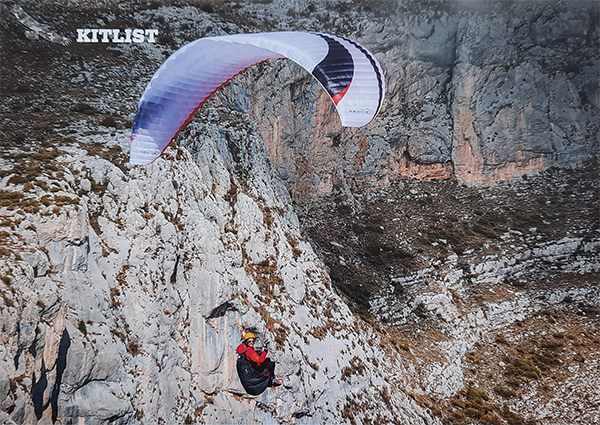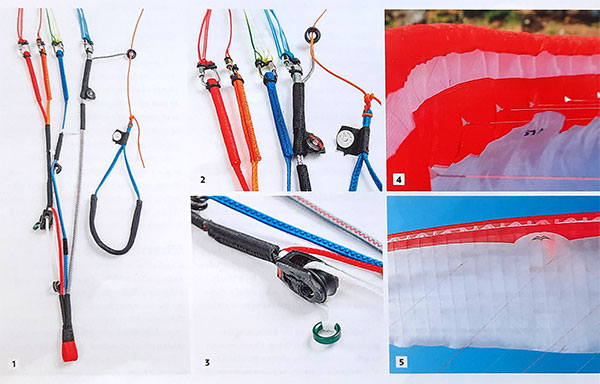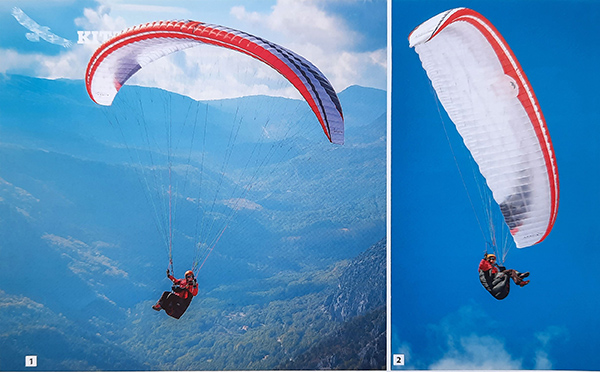Marcus and Charlie King share the fun on this lightweight but performant EN A. Mac Para’s previous mountain wing, the Outback, came in one size only but with a huge weight range. Its replacement, the Aravis, comes in six sizes covering weights from 55kg to 115kg. We took the 19m2 XS into the mountains of the southern French Alps to try it in hike-and-fly and thermalling modes.
Testpilot: Marcus and Charlie King
Fotos: Marcus King
Mac Para’s previous mountain wing, the Outback, came in one size only but with a huge weight range. Its replacement, the Aravis, comes in six sizes covering weights from 55kg to 115kg. We took the 19m² XS into the mountains of the southern French Alps to try it in hike-and-fly and thermalling modes.
Unrolling it, you quickly realise this is a much more sophisticated wing than the Outback. The cell count has gone up from 36 to 50 and the aspect has risen from 4.7 to 5.16. It looks like a higher performance wing.
Those extra cells mean the weight has risen too: the original Outback came in one size, 21m², weighing 2.7kg; the Aravis in 21m² weighs 2.97kg. This is a bit heavier than some of the other mountain wings: Gin’s Yeti-weighs 2.41kg and Ozone’s UL4 tips the scales at just 2.2kg in the same size, but these are both simpler wings. The 19m² we were testing weighs 2.72kg.
Because there are more sizes, the weight ranges are narrower than the Outback’s, although that was an EN B whereas the Aravis is EN A in all sizes, with the exception of the XXS which is EN C. Mac Para say that the XS is good for hike- and-fly up to 90kg but it should be noted it is only certified to 80kg. I flew it at around 87kg with Charlie flying it within the certified range - around 63kg with a lightweight hike-and-fly harness, and 68kg with a standard set-up. It’s a shame that Mac Para didn’t get an extended weight range certified on the 19 and 21, even if it meant a higher rating. Certification is an important consideration for many pilots, and other brands do offer this. It makes the wing that bit more attractive to a wider range of pilots.

The construction includes 3D shaping above and below the cell openings and mini ribs, things that are often missing from mountain wings. This shows that Mac Para haven’t compromised on performance to reduce weight, and what is a couple of hundred grams extra really? Once inflated, designer Petr Recek’s attention to detail is also obvious. The wing has a very smooth finish.
Materials-wise, Mac Para have used a mix to give better durability; while the main material is Porcher’s double-coated Skytex 27, the leading edge uses Skytex 32. The leading edge is supported by 0.6mm Nitinol rods. Petr told us this diameter is chosen mainly to have the right rigidity, rather than for weight. On the leading edge there are also small loops for fixing snow stakes if needed when launching on snow.
The line layout is a standard three-riser set-up with additional D attachment points. The upper lines, which generally rest on the canopy on the ground, are unsheathed and a little floss-like. As you go down the main lines you will find sheathed lines that are colour coded, making getting things sorted on launch much easier. That colour coding is continued onto the risers.

Although technically the risers are bootlace Dyneema-type, they are covered in material that makes them really easy to handle, in different colours so you can identify them easily. It’s perfect for when you arrive on launch feeling a bit tired. The lines are attached with maillons rather than softlinks, making line changes easier.
Brake handles are comfortable to use and have magnetic keepers, and the speed system has a metal loop rather than a Brummel hook, the idea being you use a prusik loop to attach the speed bar. As you would expect from Mac Para, everything is well finished.
Our review wing was supplied with its own compress-style concertina bag. Its simple design is a sheet with clips (no zip), and the sides can be rolled up to adjust the size, then secured with the clips. There is a riser bag built in, and a lightweight inner bag it all fits inside to make for a neatly and small-packed wing. It could benefit from a little more compression to be able to really compact it for hiking.
Laying out is a doddle thanks to the glider’s colour-coded lines and risers. The only slight negative is that the fine lines near the wing can catch on plants or rocks, although with a bit of care you should be able to lay these on the wing.
Despite the complex structure the wing fills easily on launch. It rises smoothly in even the lightest of winds, and in strong breezes it doesn’t become a handful. It is all super easy and stress-free. I had no problem with forward launches on nil-wind days either - the wing fills easily and rises smoothly overhead with very little correction needed.
In my tests I flew the wing at around 87kg, which is near the top of the hike-and-fly range specified by Mac Para. This is outside of the EN certified range. In the air this feels more like a sleek flying craft than other lower cell-count wings in its class. It feels like it carves through the air, staying solidly above you as it cuts through the turbulence without much pitching.
I was impressed by the amount of lift generated by the 19m² wing. Plenty enough to soar our local cliffs, given a bit of morning lift. Turns are dynamic as you would expect, and it will dive but retains the energy well, converting it into height as you level out. A subtler touch can keep things reasonably efficient, but it is fun to hook it round and then convert the energy into height.
Carving a series of turns can take you down the terrain in a controlled way, with plenty of energy available should you need to pull up. Wingovers are equally fun and it is of course very easy to get above the wing. Spirals felt easy to control and you can bleed the energy as you come out.
As you would expect from a double-surface wing the landing flare is great and timing isn’t super sensitive, making it very easy to land even in less than perfect terrain. With a bit of speed on approach, nil-wind landings are no problem.

Charlie also had a few flights on the Aravis. Falling in the middle of the weight range gives a slightly different flying experience. You get the same easy launch and landing, but the world of thermalling and site-cruising is opened up to you too. She had a fun midday session on it one autumn day at Gréolières.
Flying at around 68kg with the Gin Switch 2 harness, it was simply F-U-N! It’s small and compact with nice brake pressure and direct controls which means it’s easy to place and turn in small bits of lift. She said it thermalled beautifully, and this, combined with its EN-A comfort and decent glide makes it a wing to just relax and have fun on.
Other pilots asked how “the little mountain wing” was, but really it’s more than that - it’s a lightweight EN-A glider that can hold its own on a flying site, as well as being a hike-and-fly machine. Flying alongside her it seemed performance was good and she was keeping up with the low-Bs.
It seems depending on the size you choose this wing covers many different uses. Weighted up it makes a great hike-and-fly wing, especially for experienced pilots who will appreciate the more refined handling.
Going up a size or two will give you a great and well-performing lightweight EN-A, perfect for travel and for starting vol-biv adventures, with plenty of thermalling and cross-country performance. Yes it weighs a little more than some of its competitors but you get a more capable, more refined wing in exchange for those few grams. XC
Marcus flew the Mac Para Aravis 19 at around 86kg using a Skywalk Core harness. Charlie King flew the wing at a take-off weight of 68kg with the Gin Switch 2 harness.